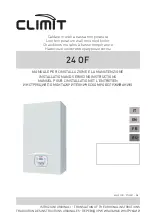
53
DynaMax HS Controller are always closed. Auto reset
limits are fixed in all Modes.
•
With the boiler running, check for flue gas leaks along
the inner cabinet joints and around the flue outlet.
•
Repair any leaks prior to proceeding to the next step.
•
At the factory, adjustments were made to achieve
proper input and acceptable burner performance at full
input and at minimum input.
10.3
HEATING BOILER INSTALLATIONS
Before beginning the installation, consult local codes for
specific plumbing requirements. The installation should have
unions and valves at the inlet and outlet of the appliance so
it can be isolated for service. An air separation device must
be supplied in the installation piping to eliminate trapped air
in the system. Locate a system air vent at the highest point
in the system. The system must also have a properly sized
expansion tank installed. Typically, an air charged
diaphragm-type expansion tank is used. The expansion tank
must be installed close to the boiler and on the suction side
of the system pump (appliance Inlet) to ensure proper
operation. Caution: This appliance should not be operated at
less than 12 PSIG cold. Pressure will rise when hot.
Expansion tank sizing will determine the pressure when the
system is hot. Do not operate the system at less than 18-20
PSIG when hot. Water piping must be supported by suitable
hangers or floor stands, NOT by the appliance. Pipe systems
will be subject to considerable expansion and contraction.
Pipe supports could allow the pipe to slide resulting in noise
transmitted into the system. Padding is recommended. The
boiler pressure relief valve must be piped to a suitable floor
drain. See Section 4.11.
10.4
INSPECT & RECHARGE CONDENSATE
COLLECTION/NEUTRALIZING
RESERVOIR
1) Before starting the unit inspect the condensate
reservoir in the DynaMax HS making sure the
collection box is intact.
2) Remove screw holding lid on to condensate collection
box. Remove lid from the condensate collection box
3) Examine neutralizer medium and refill as necessary
with fresh medium
4) Fill with fresh water until the water begins to flow out of
drain
5) Re-install the lid and hold-down screw on the
condensate collection box.
WARNING
The condensate collection box must be filled with water
to prevent flue gas emissions from escaping during
boiler operation.
CAUTION
1)
A leak in a boiler “System” will cause the fill system
to introduce fresh water constantly, which may
cause the tubes to accumulate a line/scale build
up. Lime/scale buildup. This will be a
NON-
WARRANTABLE FAILURE.
2) If boiler pumps are not operated when treated water
is introduced, a corrosion cell may be created in the
boilers leading to a failure which is not covered by
warranty.
3) Target water quality of treated water to be stable and
neutral with regards to corrosive/scaling properties.
Damage to or failure of the heat exchanger as a
result of scaling or corrosive water quality is not
covered by warranty.
10.5
WATER CONNECTIONS
System pipe size must be in accordance with Table 10
(depending on model) and, between supply and return lines,
must not exceed 50 feet of equivalent length. Connection
sizes at the heater are given in Tables 3 & 5. Any reduction
in recommended pipe size may decrease flow resulting in
high temperature rise across the heat exchanger, boiler
noise, flashing to steam and non-warrantable heat
exchanger damage.
10.6
PIPING LENGTHS
The appliance circulator provides the water flow from the
primary boiler piping, through the boiler and back to the
primary system. Pipe diameter and length are critical to
ensure proper flow through the boiler.
The secondary loop piping to and from the appliance must
have a fully ported ball valve installed in both the supply and
return side piping and will be used for isolation only.
The ball
valves must be the same diameter as the installed piping
. If
flow control is required, other means of flow control such as
globe valve or flow setter should be used.
10.7
SUMMARY
a) Typical Boiler Installations
General Plumbing Rules
1) Check all local codes.
2) For serviceability, always install unions.
3) Always pipe pressure relief valve to an open
drain.
4) Locate system air vents at highest points of
system.
5) Expansion tank must be installed near the
boiler and on the suction side of the system
pump.
6) Support all water piping.
7) Place drip pan underneath boiler. (if required)
b) Placing the Boiler in Operation
Pre-Start Check List
1) Review the location of the boiler, clearances
from combustible surfaces and available
service clearances.
2) Review Part 2 Venting. Ensure that all vent
components are fabricated from the correct
category of materials with adequate clearance
from
combustibles.
Review
the
vent
termination point for proper location and
clearances.
3) If a separate combustion air pipe is used,
ensure that it is properly sized, sealed and
terminated.
4) Review the water piping from the boiler to the
system. The boiler must be installed in a
primary/ secondary piping system. Review the
diameter and equivalent length of the installed
piping to and from the boiler to ensure proper
flow.
Содержание DynaMax DMH201
Страница 2: ......
Страница 11: ...7 Figure 5 DynaMax HS Wall Hung Service Clearances Figure 6 DynaMax HS Floor Mount Service Clearances...
Страница 70: ...62 PART 14 EXPLODED VIEW PARTS LIST DYNAMAX HS WALL HUNG 10 May be located outside cabinet...
Страница 71: ...63 DYNAMAX HS FLOOR MOUNT 10 May be located outside cabinet...
Страница 77: ...69 11 6 Front Strut 14 8037 X X Not shown in Exploded View Part Recommended spare parts...
Страница 78: ...70 PART 15 ELECTRICAL DIAGRAMS 15 1 DM 200 299 INTERNAL WIRING DIAGRAM...
Страница 79: ...71 15 2 DM 399 800 INTERNAL WIRING DIAGRAM...
Страница 80: ...72...
















































